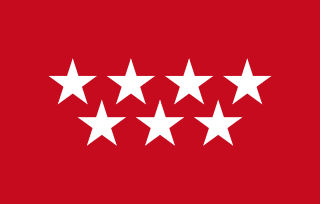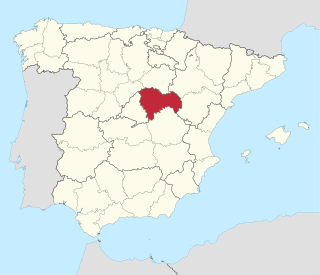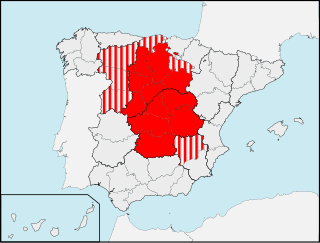
The Iberian Peninsula, also known as Iberia, is a peninsula in south-western Europe, defining the westernmost edge of Eurasia. Separated from the rest of the European landmass by the Pyrenees, it includes the territories of Peninsular Spain and Continental Portugal, comprising most of the region, as well as the tiny adjuncts of Andorra, the British Overseas Territory of Gibraltar, and, pursuant to the traditional definition of the Pyrenees as the peninsula's northeastern boundary, a small part of France. With an area of approximately 583,254 square kilometres (225,196 sq mi), and a population of roughly 53 million, it is the second-largest European peninsula by area, after the Scandinavian Peninsula.

Spain is a country located in southwestern Europe occupying most of the Iberian Peninsula. It also includes a small exclave inside France called Llívia, as well as the Balearic Islands in the Mediterranean, the Canary Islands in the Atlantic Ocean 108 km (67 mi) off northwest Africa, and five places of sovereignty on and off the coast of North Africa: Ceuta, Melilla, Islas Chafarinas, Peñón de Alhucemas, and Peñón de Vélez de la Gomera.

Toledo is a city and municipality of Spain, the capital of the province of Toledo and the de jure seat of the government and parliament of the autonomous community of Castilla–La Mancha.

The Tagus is the longest river in the Iberian Peninsula. The river rises in the Montes Universales near Teruel, in mid-eastern Spain, flows 1,007 km (626 mi), generally westward, and empties into the Atlantic Ocean in Lisbon.

The Community of Madrid is one of the seventeen autonomous communities of Spain. It is located in the centre of the Iberian Peninsula, and of the Central Plateau. Its capital and largest municipality is the City of Madrid, which is also the capital of the country. The Community of Madrid is bounded to the south and east by Castilla–La Mancha and to the north and west by Castile and León. It was formally created in 1983, in order to address the particular status of the City of Madrid as the national capital city and in urban hierarchy. Its limits are those of the province of Madrid, which was until then conventionally included in the historical region of New Castile.

Castilla–La Mancha is an autonomous community of Spain. Comprising the provinces of Albacete, Ciudad Real, Cuenca, Guadalajara and Toledo, it was created in 1982. The government headquarters are in Toledo, which is the capital de facto.

Guadalajara is a province of Spain, belonging to the autonomous community of Castilla–La Mancha. As of 2019 it had a population of 258,890 people. The population of the province has grown in the last 10 years. It is located in the centre of the Iberian Peninsula.

The Iberians were an ancient people settled in the eastern and southern coasts of the Iberian Peninsula, at least from the 6th century BCE. They are described in Greek and Roman sources. Roman sources also use the term Hispani to refer to the Iberians.

The Vettones were an Iron Age pre-Roman people of the Iberian Peninsula.

The Sierra Morena is one of the main systems of mountain ranges in Spain. It stretches for 450 kilometres from east to west across the south of the Iberian Peninsula, forming the southern border of the Meseta Central plateau and providing the watershed between the valleys of the Guadiana to the north and the west, and the Guadalquivir to the south.

The Ilercavones were an ancient Iberian (Pre-Roman) people of the Iberian Peninsula. They are believed to have spoken an Iberian language.

The Autrigones were a pre-Roman tribe that settled in the north of the Iberian Peninsula, in what today is the western Basque Country and northern Burgos and the East of Cantabria, Spain. Their territory limited with the Cantabri territory at west, the Caristii at east, the Berones at the southeast and the Turmodigi at the south. It is discussed whether the Autrigones were Celts, theory supported by the existence of toponyms of Celtic origin, such as Uxama Barca and other with -briga endings and that eventually underwent a Basquisation along with other neighboring tribes such as the Caristii and Varduli.

The Sierra de Guadarrama is a mountain range forming the main eastern section of the Sistema Central, the system of mountain ranges along the centre of the Iberian Peninsula. It is located between the systems Sierra de Gredos in the province of Ávila, and Sierra de Ayllón in the province of Guadalajara.

The Carpetani were one of the Celtic peoples inhabiting the Iberian Peninsula prior to the Roman conquest. Their core domain was constituted by the lands between the Tagus and the Anas, in the southern Meseta. Agriculture is thought to have had a greater importance in the Carpetanian economy than other neighboring peoples'.

Castilians are the inhabitants of the historical region of Castile. However, the region's exact limits are disputed.

The Region of Murcia is an autonomous community of Spain located in the southeastern part of the Iberian Peninsula, on the Mediterranean coast. The region is 11,313 km2 (4,368 sq mi) in area and had a population of 1,511,251 as at the start of 2020. About a third of its population lives in the capital, Murcia, and a seventh in the second city, Cartagena. At 2,014 m (6,608 ft), the region's highest point is Los Obispos Peak in the Massif of Revolcadores.

Hispania was the Roman name for the Iberian Peninsula. Under the Roman Republic, Hispania was divided into two provinces: Hispania Citerior and Hispania Ulterior. During the Principate, Hispania Ulterior was divided into two new provinces, Baetica and Lusitania, while Hispania Citerior was renamed Hispania Tarraconensis. Subsequently, the western part of Tarraconensis was split off, initially as Hispania Nova, which was later renamed "Callaecia". From Diocletian's Tetrarchy onwards, the south of the remainder of Tarraconensis was again split off as Carthaginensis, and all of the mainland Hispanic provinces, along with the Balearic Islands and the North African province of Mauretania Tingitana, were later grouped into a civil diocese headed by a vicarius. The name Hispania was also used in the period of Visigothic rule.

The Olcades were an ancient stock-raising pre-Roman people from Hispania, who lived to the west of the Turboletae in the southeastern fringe of the Iberian system mountains.

The topographical relief of Spain is characterized by being quite high, with an average altitude of 660 meters above sea level, quite mountainous compared to other European countries and only surpassed by Switzerland, Austria, Albania, Montenegro, North Macedonia and the microstates of Andorra and Liechtenstein. In peninsular Spain, the terrain is articulated around a large Meseta Central that occupies most of the center of the Iberian Peninsula. Outside the plateau, there is the depression of the Guadalquivir river, located in the southwest of the peninsula, and the Ebro river depression, located in the northeast.
















